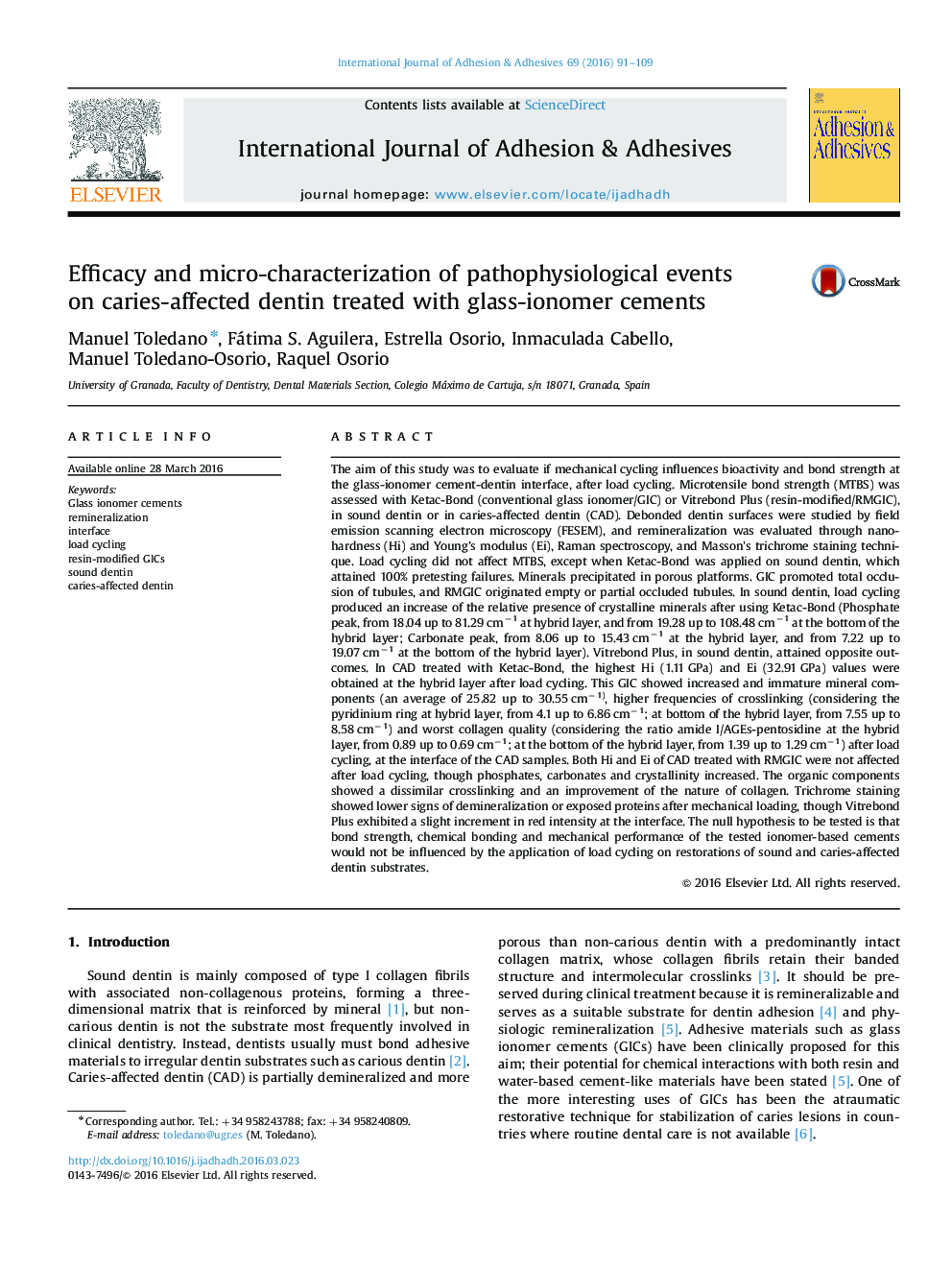| کد مقاله | کد نشریه | سال انتشار | مقاله انگلیسی | نسخه تمام متن |
|---|---|---|---|---|
| 779841 | 1463468 | 2016 | 19 صفحه PDF | دانلود رایگان |
The aim of this study was to evaluate if mechanical cycling influences bioactivity and bond strength at the glass-ionomer cement-dentin interface, after load cycling. Microtensile bond strength (MTBS) was assessed with Ketac-Bond (conventional glass ionomer/GIC) or Vitrebond Plus (resin-modified/RMGIC), in sound dentin or in caries-affected dentin (CAD). Debonded dentin surfaces were studied by field emission scanning electron microscopy (FESEM), and remineralization was evaluated through nanohardness (Hi) and Young’s modulus (Ei), Raman spectroscopy, and Masson׳s trichrome staining technique. Load cycling did not affect MTBS, except when Ketac-Bond was applied on sound dentin, which attained 100% pretesting failures. Minerals precipitated in porous platforms. GIC promoted total occlusion of tubules, and RMGIC originated empty or partial occluded tubules. In sound dentin, load cycling produced an increase of the relative presence of crystalline minerals after using Ketac-Bond (Phosphate peak, from 18.04 up to 81.29 cm−1 at hybrid layer, and from 19.28 up to 108.48 cm−1 at the bottom of the hybrid layer; Carbonate peak, from 8.06 up to 15.43 cm−1 at the hybrid layer, and from 7.22 up to 19.07 cm−1 at the bottom of the hybrid layer). Vitrebond Plus, in sound dentin, attained opposite outcomes. In CAD treated with Ketac-Bond, the highest Hi (1.11 GPa) and Ei (32.91 GPa) values were obtained at the hybrid layer after load cycling. This GIC showed increased and immature mineral components (an average of 25.82 up to 30.55 cm−1), higher frequencies of crosslinking (considering the pyridinium ring at hybrid layer, from 4.1 up to 6.86 cm−1; at bottom of the hybrid layer, from 7.55 up to 8.58 cm−1) and worst collagen quality (considering the ratio amide I/AGEs-pentosidine at the hybrid layer, from 0.89 up to 0.69 cm−1; at the bottom of the hybrid layer, from 1.39 up to 1.29 cm−1) after load cycling, at the interface of the CAD samples. Both Hi and Ei of CAD treated with RMGIC were not affected after load cycling, though phosphates, carbonates and crystallinity increased. The organic components showed a dissimilar crosslinking and an improvement of the nature of collagen. Trichrome staining showed lower signs of demineralization or exposed proteins after mechanical loading, though Vitrebond Plus exhibited a slight increment in red intensity at the interface. The null hypothesis to be tested is that bond strength, chemical bonding and mechanical performance of the tested ionomer-based cements would not be influenced by the application of load cycling on restorations of sound and caries-affected dentin substrates.
Journal: International Journal of Adhesion and Adhesives - Volume 69, September 2016, Pages 91–109
